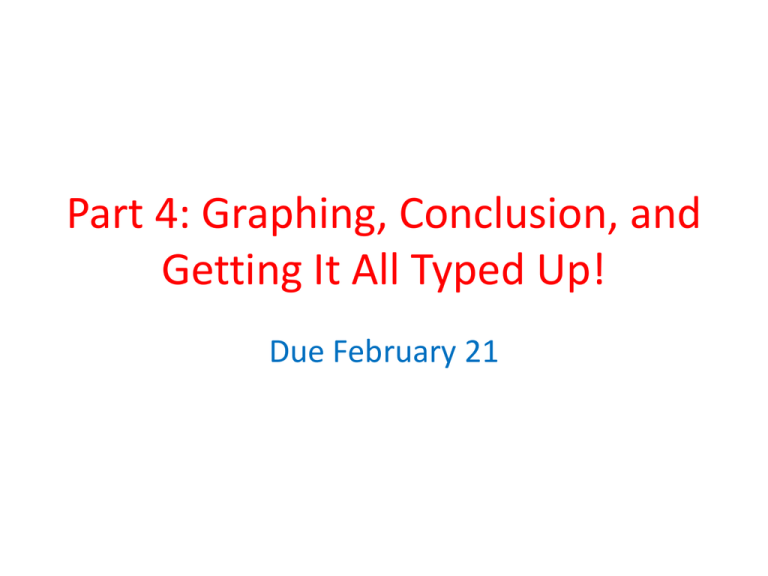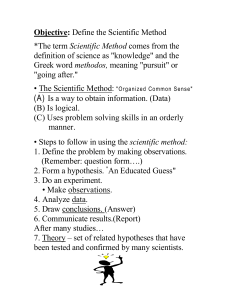Pt. 4 Graph and Conclusions
advertisement

Part 4: Graphing, Conclusion, and Getting It All Typed Up! Due February 21 Dates Where are we now? Objectives Check When Completed November 6-26 Work on finding topics and writing the independent variable, dependent variable, title, and materials in Science Lab By November 27 Part 1 Due: IV, DV, Title, and List of Materials Part 1 Completed with parent and teacher signature November 27December 20 By Friday, December 20th Work on purpose, hypothesis, and how to make a data table in Science Lab December 23January 3 Winter Break: This would be a great time to conduct your experiment if you will be home during the holidays. January 6-January 31 Work on writing constants and procedures in Science Lab. If needed, students will work on conducting the investigations in the science lab. By Friday, January 29th Part 3 Due: List Constants, Procedures, Conduct the Experiment, and Completed Data Table February 3-21 By February, 21st February 24March 14 March 14th March 19 March 20 Work on graphs and conclusions in Science Lab Part 4 Due: Graph and Conclusion Work on Tri-fold Presentation Board in Science Lab Part 2 Due: Purpose, Hypothesis, and Data Table Framework Due Part 5 Due: All boards due to homeroom teacher for review All boards turned into Mrs. Fort and Mr. Moreno Science Fair Part 2 Completed with teacher signature Part 3 Completed with teacher signature Part 4 Part 5 Finished! Looking Back at Your Data Table The data you collected during your experiment in the data table is what you are going to graph. Two Types of Data Tables: Which do you have? IV DV Quantitative Data (Numbers) IV Qualitative Data (Descriptions) DV Graphing Now, you need to decide which kind of graph you will use: • Bar graph- one snapshot in time • Line graph- data collected over a period in time – If you collected Qualitative Data (descriptions) then you will ONLY do a Bar Graph. Ask your teacher before you make your graph to ensure you are using the correct graph. Filling in the Graph in Your Packet •The three lines are for your titles. oYou should have 1 main title at the top oThen label your Y and X axis. •The X axis should have your IV levels •The Y axis should be the data from the DV Graphing Online Use the Website: http://nces.ed.gov/nceskids/createagraph/default.aspx This can also be found on the Science Fair Webpage on the Woodley Hills Website. Example of Quantitative Graph Title of Graph Temperature DV Label: Y Axis Levels of IV Always start with 0 IV Label: X Axis DV Qualitative Graph • Look back at your data table. • You need to give you observations numbers. You can do this by ranking them. – Make sure these numbers match the observations: if it was the most, then you should give it the highest number. Example: Soil Types Erosion Ranking Top Soil A lot of erosion 3 Sand Some erosion 2 Pebbles Very little erosion 1 Example of Qualitative Graph DV key to show ranking Example of a Line Graph Parts of a Conclusion Conclusion: This is the summary of your experiment written as a paragraph. It should be at least 4 sentences long. Please include: • The result of your experiment- “I conclude…” • State if your hypothesis was supported by your data or not • What the experiment taught you- “I learned…” • Write how you could improve your experiment (there is always a way to improve it!) Conclusion Example Example: I conclude that the white t-shirt was able to stay the coolest temperature after being out in the sun on a hot and sunny day for 30 minutes compared to a black and purple t-shirts. The data I found supported my hypothesis statement! I learned that when I am outside on a hot and sunny summer day I should always wear white or light colored t-shirts, so that I do not get too hot. I should not wear dark colored t-shirts, because I will get much hotter. This is because the white or light colors reflect the sunlight and do not absorb the heat energy. The dark colors absorb the sun’s energy, which turns to heat energy inside the t-shirt. If I were to do this experiment again, I would have repeated my experiment more times to make sure that I had the same results each time. That way I would be sure that my data was correct. Have you been thinking about your presentation? This year you have the choice to present your science fair project on a display board (like last year) or on a laptop presentation! What have you decided to do? Next Steps… • You need to get all your work typed!! – If you have a computer at home, you can do this at home. – Your teacher will give you time to use computers in schools. February 24March 14 March 14th March 19 March 20 Work on Tri-fold Presentation Board in Science Lab Part 5 Part 5 Due: All boards due to homeroom teacher for review All boards turned into Mrs. Fort and Mr. Moreno Science Fair Finished! Extra Help Don’t forget Dr. Mahoney still comes from 13:00 every Thursday. Sign up outside of the science lab. Typing/Making Presentations Help Times in the Computer Lab: • Mr. Veasley- every morning 8:20-8:50 AM • Mrs. Fort- every Monday 9:30-10:15 AM
